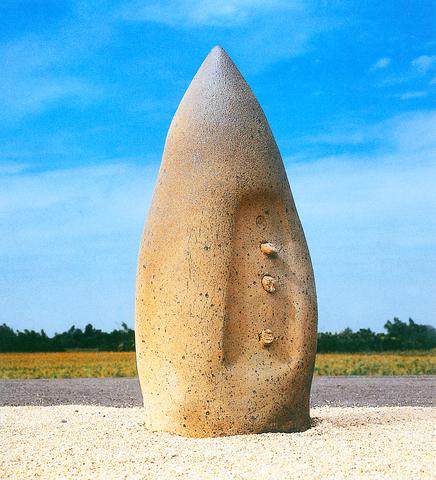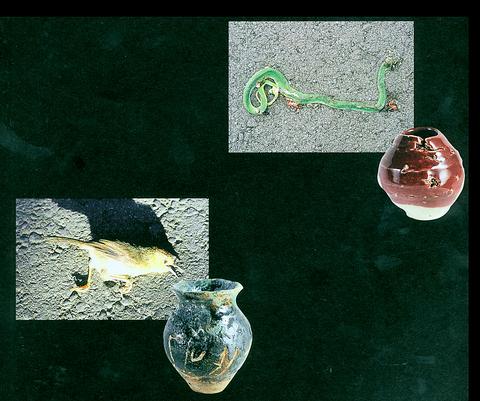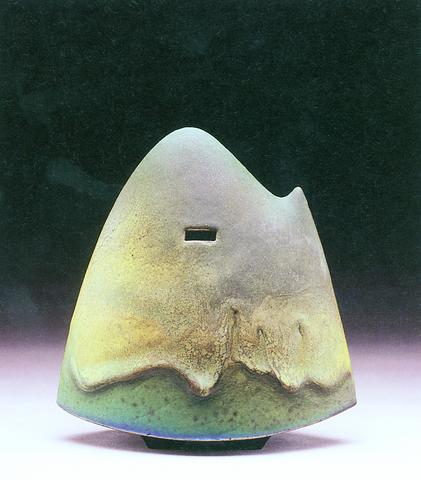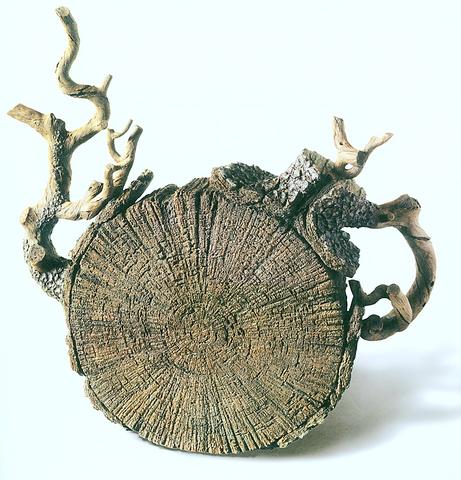Since Taipei County's Yingko Ceramics Museum opened in 2000 to promote ceramic art, the National Museum of History (
Calefaction and Diffusion (
The four artists, Yang Yuan-tai (

"Unrestrained by `exquisiteness' and `modesty' in traditional ceramics ... the four artists have in common a willing to create cross-disciplinary works and an open-mindedness," said Huang Hai-ming, installation artist and art critic.
The most eye-catching works may be Lo's installations and documents of his performances, some of which did not even involve ceramics.
Born in Chiayi, Lo has had a strong affection for land and earth since childhood, which was spent playing with clay. He later came to realize the vital connection between humans and earth. "After my grandmother had been dead for several years, my family went to her grave for "bone-picking." When the lid of the coffin was lifted, I saw only earth. My grandma had turned into earth. ... The same will happen to everyone. ... If you spit on the ground, you might be spitting on your own corpse from your last life," Lo said in a documentary about him, which is also on show.

Restoration Project (
Concerned about Taiwan's environment, Lo made Land Survey (
Treating ceramics objects as mini architectural pieces, Kuo leaves a small window-like square opening near the top of each work. Viewers can only wonder what or who remains hidden inside those "buildings."

Ah Leon was a craftsman of traditional Yixing pottery. During his study trip to the US, it occurred to him that the new direction for Taiwanese ceramics is not to blindly emulate international ceramic techniques, but to express the country's characteristics. His imitation wooden pots and tofu, popular among collectors, are his effort to create something that appears genuinely Taiwanese.
Yang often presents his ceramic works as if they are sculptures. He would place them in the outdoors and take photos of them from angles that make them appear to be several meters tall. Although these works are shown not in photos, but placed as they are in the gallery, they still convey a sense of serenity and geometric harmony.
What: Calefaction and Diffusion -- Works by Four Ceramicists

Where: National Museum of History, 49, Nanhai Rd., Taipei (
When: Through Sept. 8

Wooden houses wedged between concrete, crumbling brick facades with roofs gaping to the sky, and tiled art deco buildings down narrow alleyways: Taichung Central District’s (中區) aging architecture reveals both the allure and reality of the old downtown. From Indigenous settlement to capital under Qing Dynasty rule through to Japanese colonization, Taichung’s Central District holds a long and layered history. The bygone beauty of its streets once earned it the nickname “Little Kyoto.” Since the late eighties, however, the shifting of economic and government centers westward signaled a gradual decline in the area’s evolving fortunes. With the regeneration of the once

Even by the standards of Ukraine’s International Legion, which comprises volunteers from over 55 countries, Han has an unusual backstory. Born in Taichung, he grew up in Costa Rica — then one of Taiwan’s diplomatic allies — where a relative worked for the embassy. After attending an American international high school in San Jose, Costa Rica’s capital, Han — who prefers to use only his given name for OPSEC (operations security) reasons — moved to the US in his teens. He attended Penn State University before returning to Taiwan to work in the semiconductor industry in Kaohsiung, where he

In February of this year the Taipei Times reported on the visit of Lienchiang County Commissioner Wang Chung-ming (王忠銘) of the Chinese Nationalist Party (KMT) and a delegation to a lantern festival in Fuzhou’s Mawei District in Fujian Province. “Today, Mawei and Matsu jointly marked the lantern festival,” Wang was quoted as saying, adding that both sides “being of one people,” is a cause for joy. Wang was passing around a common claim of officials of the People’s Republic of China (PRC) and the PRC’s allies and supporters in Taiwan — KMT and the Taiwan People’s Party — and elsewhere: Taiwan and

Perched on Thailand’s border with Myanmar, Arunothai is a dusty crossroads town, a nowheresville that could be the setting of some Southeast Asian spaghetti Western. Its main street is the final, dead-end section of the two-lane highway from Chiang Mai, Thailand’s second largest city 120kms south, and the heart of the kingdom’s mountainous north. At the town boundary, a Chinese-style arch capped with dragons also bears Thai script declaring fealty to Bangkok’s royal family: “Long live the King!” Further on, Chinese lanterns line the main street, and on the hillsides, courtyard homes sit among warrens of narrow, winding alleyways and